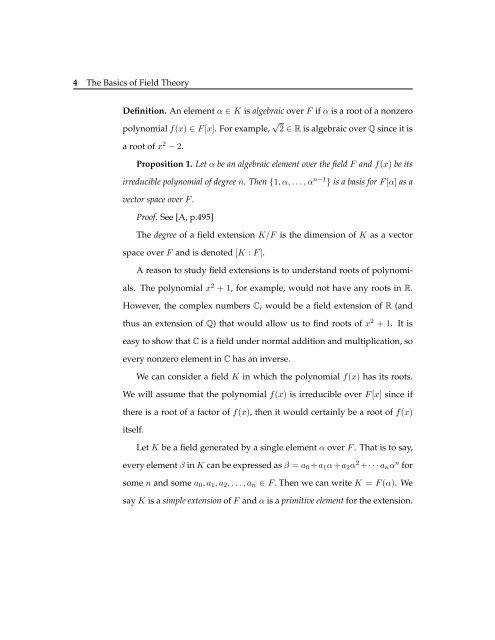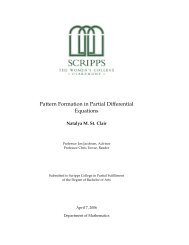Galois Theory: A Study of Cyclotomic Field ... - Scripps College
Galois Theory: A Study of Cyclotomic Field ... - Scripps College
Galois Theory: A Study of Cyclotomic Field ... - Scripps College
Create successful ePaper yourself
Turn your PDF publications into a flip-book with our unique Google optimized e-Paper software.
4 The Basics <strong>of</strong> <strong>Field</strong> <strong>Theory</strong><br />
Definition. An element α ∈ K is algebraic over F if α is a root <strong>of</strong> a nonzero<br />
polynomial f(x) ∈ F [x]. For example, √ 2 ∈ R is algebraic over Q since it is<br />
a root <strong>of</strong> x 2 − 2.<br />
Proposition 1. Let α be an algebraic element over the field F and f(x) be its<br />
irreducible polynomial <strong>of</strong> degree n. Then {1, α, . . . , α n−1 } is a basis for F [α] as a<br />
vector space over F .<br />
Pro<strong>of</strong>. See [A, p.495]<br />
The degree <strong>of</strong> a field extension K/F is the dimension <strong>of</strong> K as a vector<br />
space over F and is denoted [K : F ].<br />
A reason to study field extensions is to understand roots <strong>of</strong> polynomials.<br />
The polynomial x 2 + 1, for example, would not have any roots in R.<br />
However, the complex numbers C, would be a field extension <strong>of</strong> R (and<br />
thus an extension <strong>of</strong> Q) that would allow us to find roots <strong>of</strong> x 2 + 1. It is<br />
easy to show that C is a field under normal addition and multiplication, so<br />
every nonzero element in C has an inverse.<br />
We can consider a field K in which the polynomial f(x) has its roots.<br />
We will assume that the polynomial f(x) is irreducible over F [x] since if<br />
there is a root <strong>of</strong> a factor <strong>of</strong> f(x), then it would certainly be a root <strong>of</strong> f(x)<br />
itself.<br />
Let K be a field generated by a single element α over F . That is to say,<br />
every element β in K can be expressed as β = a 0 +a 1 α+a 2 α 2 +· · · a n α n for<br />
some n and some a 0 , a 1 , a 2 , . . . , a n ∈ F. Then we can write K = F (α). We<br />
say K is a simple extension <strong>of</strong> F and α is a primitive element for the extension.
















